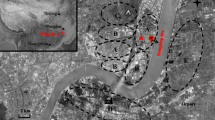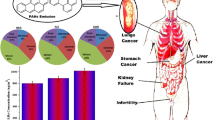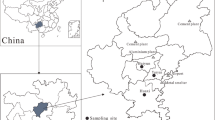Abstract
An analysis of 12 polycyclic aromatic hydrocarbons (PAHs) in PM2.5 (particulate matter with a diameter smaller than 2.5 microns) samples collected at Yucheng, Shandong, in June 2013 was conducted to determine the concentrations, composition, sources, and associated cancer risk. The results revealed that the average PAH concentration was higher during haze episodes (28.28 ± 8.35 ng m−3) when compared to non-haze episodes (23.68 ± 4.17 ng m−3), and diagnostic ratio and principal component analyses indicate that the predominant sources of PAHs were from fossil fuel and coal combustion, likely from vehicle emissions and industrial sources and biomass burning. Coal combustion and biomass burning contributed significantly more during haze episodes, whereas liquid fossil fuel combustion (e.g. petroleum) was the dominant contributor during the non-haze periods. In addition, back-trajectory calculations revealed that the long-distance transport of air masses from regions with industrial pollution and biomass burning contributed significantly to the concentrations of PAHs in the region. The concentration of high molecular weight PAHs (HMW-PAHs) increased from 62.3 % under non-haze conditions to 67.9 % during the haze periods. The benzo[a]pyrene-equivalent carcinogenic potency value during haze episodes was higher (7.09 ng m−3) than that during non-haze (5.64 ng m−3) periods and adults over 30 years old in the Shandong province are at an increased risk of cancer from PAHs.




Similar content being viewed by others
References
Cao GL, Zhang XY, Wang YQ, Zheng FC (2008) Estimation of emissions from field burning of crop straw in China. Chin Sci Bull 53:784–790
Chen SC, Liao CM (2006) Health risk assessment on human exposed to environmental polycyclic aromatic hydrocarbons pollution sources. Sci Total Environ 366:112–123
Chiang KC, Chio CP, Chiang YH, Liao CM (2009) Assessing hazardous risks of human exposure to temple airborne polycyclic aromatic hydrocarbons. J Hazard Mater 166:676–685
China, Ministry of Environmental Protection of The People’s Republic of China (2012) Ambient air quality standards (GB3095-2012, in Chinese). Available from: http://www.chinacsrmap.org/
De Andrade SJ, Cristale J, Silva FS, Zocolo GJ, Marchi MRR (2010) Contribution of sugar-cane harvesting season to atmospheric contamination by polycyclic aromatic hydrocarbons (PAHs) in Araraquara city, Southeast Brazil. Atmos Environ 44:2913–2919
Dong TTT, Lee BK (2009) Characteristics, toxicity, and source apportionment of polycylic aromatic hydrocarbons (PAHs) in road dust of Ulsan, Korea. Chemosphere 74:1245–1253
Duan JC, Guo SJ, Tan JH, Wang SL, Chai FH (2012) Characteristics of atmospheric carbonyls during haze days in Beijing, China. Atmos Res 114:17–27
Fang M, Zheng M, Wang F, To KL, Jaafar AB, Tong SL (1999) The solvent-extractable organic compounds in the Indonesia biomass burning aerosols-characterization studies. Atmos Environ 33:783–795
Fu PQ, Kawamura K, Chen J, Li J, Sun YL, Liu Y et al (2012) Diurnal variations of organic molecular tracers and stable carbon isotopic composition in atmospheric aerosols over Mt. Tai in the North China Plain: an influence of biomass burning. Atmos Chem Phys 12:8359–8375
Guo H, Lee SC, Ho KF, Wang XM, Zou SC (2003a) Particle-associated polycyclic aromatic hydrocarbons in urban air of Hong Kong. Atmos Environ 37:5307–5317
Guo ZG, Sheng LF, Feng JL, Fang M (2003b) Seasonal variation of solvent extractable organic compounds in the aerosols in Qingdao, China. Atmos Environ 37:1825–1834
Han B, Ding X, Bai ZP, Kong SF, Guo GH (2011) Source analysis of particulate matter associated polycyclic aromatic hydrocarbon (PAHs) in an industrial city in northeastern China. J Environ Monitor 13:2597–2604
Harrison RM, Smith DJT, Luhana L (1996) Source apportionment of atmospheric polycyclic aromatic hydrocarbons collected from an urban location in Birmingham, UK. Environ Sci Technol 30:825–832
Hassanien MA, Abdel-Latif NM (2008) Polycyclic aromatic hydrocarbons in road dust over Greater Cairo, Egypt. J Hazard Mater 151:247–254
Hu J, Liu CQ, Zhang GP, Zhang YL (2012) Seasonal variation and source apportionment of PAHs in TSP in the atmosphere of Guiyang, Southwest China. Atmos Res 118:271–279
Ilias GK, Euripides GS (2002) Particle size distribution of organic primary and secondary aerosol constituents in urban, background marine, and forest atmosphere. J Geophys Res 107:1–12
Khalili NR, Scheff PA, Holsen TM (1995) PAH source fingertrips for coke ovens, diesel and gasoline engines, highway tunnels, and wood combustion emissions. Atmos Environ 29:533–542
Koe LCC, Arellano AF, McGregor JL (2001) Investigating the haze transport from 1997 biomass burning in Southeast Asia: its impact upon Singapore. Atmos Environ 35:2723–2734
Lai CH, Chen KS, Wang HK (2009) Influence of rice straw burning on the levels of polycyclic aromatic hydrocarbons in agricultural county of Taiwan. J Environ Sci 21:1200–1207
Larsen RK, Baker JE (2003) Source apportionment of polycyclic aromatic hydrocarbons in the urban atmosphere: a comparison of three methods. Environ Sci Technol 37:1873–1881
Li WJ, Shao LY, Buseck PR (2010) Haze types in Beijing and the influence of agricultural biomass burning. Atmos Chem Phys 10:8119–8130
Li W, Wang C, Wang HQJ, Chen JW, Shen HZ, Shen GF et al (2014) Atmospheric polycyclic aromatic hydrocarbons in rural and urban areas of northern China. Environ Pollut 192:83–90
Liao CM, Chiang KC (2006) Probabilistic risk assessment for personal exposure to carcinogenic polycyclic aromatic hydrocarbons in Taiwanese temples. Chemosphere 63:1610–1619
Ma WL, Li YF, Qi H, Sun DZ, Liu LY, Wang DG (2010) Seasonal variations of sources of polycyclic aromatic hydrocarbons (PAHs) to a northeastern urban city, China. Chemosphere 79:441–447
Mostert MMR, Ayoko GA, Kokot S (2010) Application of chemometrics to analysis of soil pollutants. Trends Anal Chem 29:430–435
Mu Q, Zhang SQ (2013) The economic cost evaluation of haze event in China. Available from: http://www.paper.edu.cn/releasepaper/content/ 05–493
Nisbet IC, LaGoy PK (1992) Toxic equivalency factors (TEFs) for polycyclic aromatic hydrocarbons (PAHs). Regul Toxicol Pharmacol 16:290–300
Oros DR (2006) Identification and emission factors of molecular tracers in organic aerosols from biomass burning: part 3. Grasses. Appl Geochem 21:919–940
Peng C, Chen WP, Liao XL, Wang ME, Ouyang ZY, Jiao WT et al (2011) Polycyclic aromatic hydrocarbons in urban soils of Beijing: status, sources, distribution and potential risk. Environ Pollut 159:802–808
Phoothiwut S, Junyapoon S (2013) Size distribution of atmospheric particulates and particulate-bound polycyclic aromatic hydrocarbons and characteristics of PAHs during haze period in Lampang Province, Northern Thailand. Air Qual Atmos Health 6:397–405
Shen G, Zhang Y, Wei S, Chen YC, Yang CL, Lin PC et al (2014) Indoor/outdoor pollution level and personal inhalation exposure of polycyclic aromatic hydrocarbons through biomass fuelled cooking. Air Qual Atmos Health 7:449–458
Sienra MR, Rosazza NG, Préndez M (2005) Polycyclic aromatic hydrocarbons and their molecular diagnostic ratios in urban atmospheric respirable particulate matter. Atmos Res 75:267–281
Tan JH, Guo SJ, Ma YL, Duan JC, Cheng Y, He KB, Yang F (2011) Characteristics of particulate PAHs during a typical haze episode in Guangzhou, China. Atmos Res 102:91–98
USEPA (United States Environmental Protection Agency) (2005) Guidelines for carcinogenic risk assessment. Available from: http://www.epa.gov/raf/publications/pdfs/CANCER_GUIDELINES_FINAL_3-25-05PDF. Accessed November 2013
Venkataraman C, Lyons JM, Friedlander SK (1994) Size distributions of polycyclic aromatic hydrocarbons and elemental carbon 1 Sampling, measurement methods, and source characterization. Environ Sci Technol 28:555–562
Ventafridda V, Tamburini M, Caraceni A, De Conno F, Naldi F (1987) A validation study of the WHO method for cancer pain relief. Cancer 59:850–856
Wang Y, Zhuang GS, Sun Y, An ZS (2006) The variation of characteristics and formation mechanisms of aerosols in dust, haze, and clear days in Beijing. Atmos Environ 40:6579–6591
Watson JG (2002) Visibility: science and regulation. J Air Waste Manage Assoc 52:628–713
Wen L, Chen JM, Yang LX, Wang XF, Xu CH, Sui X et al (2015) Enhanced formation of fine particulate nitrate at a rural site on the North China Plain in summer: the important roles of ammonia and ozone. Atmos Environ 101:294–302
Wu SP, Tao S, Xu FL, Dawson R, Lan T, Li BG, Cao J (2005) Polycyclic aromatic hydrocarbons in dustfall in Tianjin, China. Sci Total Environ 345:115–126
Wu F, Liu XP, Wang W, Yu BM, Chan CY, Liu WX et al (2015) Characterization of particulate-bound PAHs in rural households using different types of domestic energy in Henan Province, China. Sci Total Environ 536:840–846
Xu FL, Qin N, Zhu Y, HeW KXZ, Barbour MT et al (2013a) Multimedia fate modeling of polycyclic aromatic hydrocarbons (PAHs) in Lake Small Baiyangdian, Northern China. Ecol Model 252:246–257
Xu WZ, Chen H, Li DH, Zhao FS, Yang Y (2013b) A case study of aerosol characteristics during a haze episode over Beijing. Procedia Environ Sci 18:404–411
Yan XY, Ohara T, Akimoto H (2006) Bottom-up estimate of biomass burning in mainland China. Atmos Environ 40:5262–5273
Yang SJ, He HP, Lu SL, Chen D, Zhu JX (2008) Quantification of crop residue burning in the field and its influence on ambient air quality in Suqian, China. Atmos Environ 42:1961–1969
Yunker MB, Macdonald RW, Vingarzan R, Mitchell RH, Goyette D, Sylvestre S (2002) PAHs in the Fraser River basin: a critical appraisal of PAH ratios as indicators of PAH source and composition. Org Geochem 33:489–515
Zhang Q, Streets DG, Carmichael GR, He KB, Huo H, Kannari A et al (2009) Asian emissions in 2006 for the NASA INTEX-B mission. Atmos Chem Phys 9:5131–5153
Zhang YX, Tao S (2009) Global atmospheric emission inventory of polycyclic aromatic hydrocarbons (PAHs) for 2004. Atmos Environ 43:812–819
Zhang YX, Tao S, Cao J, Coveney RM (2007) Emission of polycyclic aromatic hydrocarbons in China by county. Environ Sci Technol 41:683–687
Zhang HB, Luo YM, Wong MH, Zhao QG, Zhang GL (2006) Distributions and concentrations of PAHs in Hong Kong soils. Environ Pollut 141:107–114
Zhou JB, Wang TG, Huang YB, Mao T, Zhong NN (2005) Size distribution of polycyclic aromatic hydrocarbons in urban and suburban sites of Beijing, China. Chemosphere 61:792–799
Zhu YH, Yang LX, Yuan Q, Yan C, Dong C, Meng CP et al (2013) Airborne particulate polycyclic aromatic hydrocarbon (PAH) pollution in a background site in the North China Plain: concentration, size distribution, toxicity and sources. Sci Total Environ 466–467:357–368
Zhu YH, Yang LX, Meng CP, Yuan Q, Yan C, Dong C et al (2015) Indoor/outdoor relationships and diurnal/nocturnal variations in water-soluble ion and PAH concentrations in the atmospheric PM2.5 of a business office area in Jinan, a heavily polluted city in China. Atmos Res 153:276–285
Acknowledgements
The funding of this research was supported by the Taishan Scholar Grant (ts20120552), the National Natural Science Foundation of China (Nos. 21307074 and 21577079), and the Fundamental Research Funds of Shandong University (No. 2014GN010).
Author information
Authors and Affiliations
Corresponding author
Rights and permissions
About this article
Cite this article
Lu, W., Yang, L., Chen, J. et al. Identification of concentrations and sources of PM2.5-bound PAHs in North China during haze episodes in 2013. Air Qual Atmos Health 9, 823–833 (2016). https://doi.org/10.1007/s11869-015-0386-8
Published:
Issue Date:
DOI: https://doi.org/10.1007/s11869-015-0386-8




